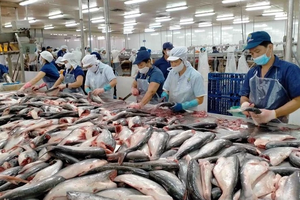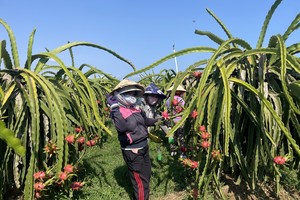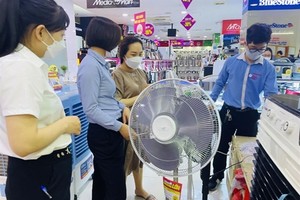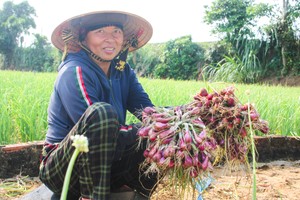The Bilateral Trade Agreement (BTA) between Viet Nam and the United States has proved to be helpful for Viet Nam’s trade, foreign investment and economic structure, particularly the bilateral trade between the two countries since the pact’s implementation in December 2001. However, the country also should be prudent when responding to any challenges that might crop up.
A boom in trade

At a seminar run by the Central Institute for Economic Management (CIEM) under the Ministry of Planning and Investment (MPI), the ministry’s Foreign Investment Department and USAID’s Support for Trade Acceleration (STAR Viet Nam) released a report on the dramatic impact of the BTA on Viet Nam over the past five years.
Le Van Ba, CIEM’s deputy director, said the most surprising effect in the first year of the BTA’s implementation was the 128% increase in Viet Nam’s export to the US. The following year, 2003, it increased a further 90 percent.
Remarkably, the export of clothing increased 1,800 percent in 2002 and a further 650 percent in the first half of 2003.
From being responsible for a small portion of Viet Nam’s export trade, the US now exceeds other countries and is Viet Nam’s largest export market.
After five years, bilateral trade between the two countries has surged nearly eight-fold, going from US$1 billion in 2001 to US$7.8 billion in 2006.
The volume of exports going to the US accounts for 20 percent of Viet Nam’s total export revenue.
The BTA has contributed to changing the structure of Vietnamese exports too. Five years ago, Viet Nam mostly shipped pre-processed goods abroad, but since the end of 2001 refined goods have accounted for 75 percent of its export trade - mostly furniture, telecommunications equipment, plastic goods, toys and travel gear.
Mr. James Riedel, senior consultant for the BTA’s technical assistance project, said that, according to the trade agreement, the US government’s main duty after the agreement came into effect was to grant Viet Nam Permanent Normal Trade Relations (PNTR) status and Most Favored Nation (MFN) status.
Since the BTA came into effect, the US has slashed the average tariff on Vietnamese goods from 40 percent to around 4 percent, whereas Viet Nam has only reduced its import tariffs on 261 items.
It means that the huge US market is opening wide for Vietnamese goods, and local government revenues are increasing dramatically in consequence.
Trade pact facilitates FDI flow into Viet Nam
There are many reasons why Viet Nam is an attractive place to invest. One of these is Viet Nam’s comprehensive and binding commitments regulated by the BTA and the World Trade Organization’s agreements.
The BTA requests basic implementation of investment procedures and policies. The concept of “investment” is defined more broadly so that it covers every investment form mentioned in the agreement.
The BTA removed the mechanism of double price determination and discriminatory treatment.
Viet Nam attracted US$12 billion in foreign direct investment in 2006, a year-on-year rise of 375 percent. This year’s figure is expected to reach US$20 billion. Many billion-dollar projects are waiting for the relevant agencies to give their approval.
The registered US projects in Viet Nam, including those done via third world countries, are capitalized at US$4 billion and have implemented projects worth US$3.3 billion.
In order to assess comprehensively the BTA’s impacts on Viet Nam’s investment environment last year, the MPI’s Foreign Investment Department has sent 4,000 questionnaires to foreign investors.
More than half responded that the BTA had been important in deciding whether to invest here or not. They said the BTA had given them more opportunities to trade.
Challenges ahead
However, everyone at the seminar agreed that the country’s export trade with the US was volatile and that many hurdles still lay ahead.
Indeed, if Viet Nam cannot overcome these obstacles, it will certainly fall into the permanent trap of cheap labor.
The question was raised of whether Viet Nam’s GDP could keep growing at 8-9 percent per annum without the US market.
Dr. Nguyen Hong Bao of Ho Chi Minh City Economics University said that, although the US investment in Viet Nam was low, it was capital-intensive and technically intensive, while Viet Nam’s export trade was labor-intensive. Therefore, he said, Viet Nam’s export trade would be overwhelmed eventually.
On the other hand, the US still does not recognize Viet Nam as having a market economy – a distinct disadvantage for Vietnamese exports.
Steve Parker, a senior economist from the STAR-Viet Nam project, warned that Viet Nam’s export trade with the US was prone to dumping lawsuits. In order to avoid damage, Vietnamese enterprises should diversify their products and gradually switch to other export markets starting now.
“The BTA only opens the first door for Viet Nam in its international economic integration process. How to use it effectively depends on the country’s policies and potentials,” he said. “Renewing and renewing ceaselessly will decide Viet Nam’s development direction in the global economy.”
| One third to one half of the total foreign indirect investment (FII) capital coming into Viet Nam up to the middle of 2006 was from the US. In Viet Nam’s stock market, FII capital from the US to Viet Nam comes from well-known companies. Particularly, JP Morgan and Citigroup have been given licensed transaction codes to officially take part in Viet Nam’s stock market. Moreover, small investors can also access Viet Nam’s stock market through investment funds. Among the investment funds related to capital from the US, Indochina Capital – a US investment bank – established a fund in Viet Nam, valued at US$100 million in 2005, and other US investors account for 45 percent of the fund’s capital. Viet Nam Partners, in a joint venture with BIDV, formed a US$100-million fund, with 30 percent from the US. IDG Venture Fund is financed by the US. It is invested in many Vietnamese companies and plans to raise its capital in Viet Nam to US$1 billion at a future date. Apart from foreign direct investment capital, there are the investment funds for foreigners. Viet Nam Fund, the first foreign fund in Viet Nam, was established in 1991 with US$54 million. A further six foreign funds were set up four years later, three of them being Viet Nam Investment Fund (US$90 million), Beta Viet Nam Fund (US$71 million), and Viet Nam Frontier Fund (US$67 million). From 2001 to the middle of 2006, more than a dozen foreign investment funds capitalized at nearly US$1 billion were established in Viet Nam. They include Mekong Enterprise Fund (US$19 million), Viet Nam Opportunity Fund (US$171 million), and Indochina Land Holding (US$100 million). Source: VNEconomy |
























